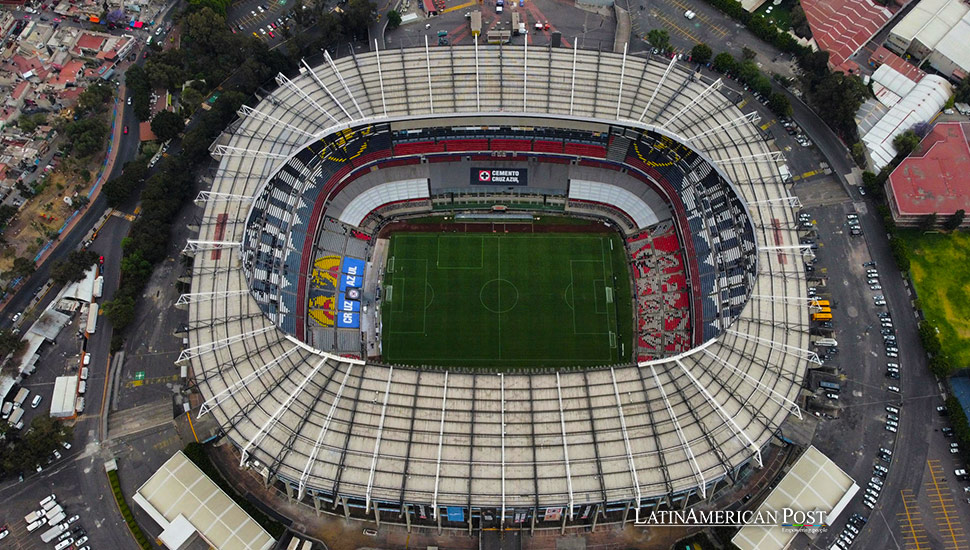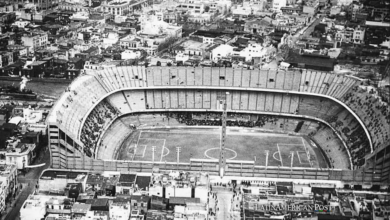Mexico’s Preparations for 2026 World Cup Remembering Pelé 70 and Maradona 86

With two years until the 2026 World Cup, Mexico is gearing up to host part of the event, drawing inspiration from the legendary performances of Pelé and Maradona at the iconic Estadio Azteca, now set for another historic inauguration.
With just two years remaining until the start of the 2026 World Cup on June 11, Mexico is preparing for the grand event, inspired by the legendary feats of Pelé and Maradona, who solidified their legacies at the Estadio Azteca. In 1970, Brazil triumphed over Italy with a 4-1 victory in the final, earning Pelé his third World Cup title at the Azteca, showcasing his artistry on the field. Sixteen years later, Maradona, the hero of Argentina, led his team to victory against Germany in a thrilling 3-2 final at the same venue.
“Those of us who experienced the 1986 World Cup will remember it as some of the best days of our lives,” stated Félix Aguirre, CEO of the Azteca. In 24 months, the stadium will become the first in history to host three World Cup inaugurations, a testament to its enduring legacy.
Preparing for a Historic Event
The 2026 World Cup is a massive event featuring 48 teams competing in 104 matches, 13 of which will occur in Mexico, including the opening match with the host team as part of Group A. The other three teams in the group will be determined in the draw at the end of 2025. Mexico City, Monterrey, and Guadalajara will serve as the host cities in Mexico, which will share the World Cup with the United States, hosting 78 matches in 11 cities, and Canada, hosting 13 games in Vancouver and Toronto.
For the World Cup opening, the Estadio Azteca will resemble a venerable tree in full bloom, more than 56 years after the historic goalless draw between Mexico and the Soviet Union on May 31, 1970, the first World Cup match at the stadium in southern Mexico City. As the World Cup approaches, the stadium, situated 2,240 meters above sea level, has begun a rejuvenation phase that includes the installation of state-of-the-art turf, increasing the capacity to 90,000 fans, structural changes, high-speed internet, and enhanced amenities for supporters.
“We have assembled a great team and aim to crown our efforts with the third World Cup inauguration at the stadium, something unlikely to be seen again in the world,” Aguirre added.
Uniting for the World Cup
Known for their hospitality, Mexicans, who hosted Latin America’s first Olympic Games in 1968, are uniting in preparation for their share of the World Cup. The capital, Monterrey and Guadalajara, are working hand in hand as if Mexico were hosting all 104 World Cup matches. Despite the initial doubts about the effort required to host a limited number of games, the enthusiasm has grown as the event approaches.
“A few years ago, some questioned whether the effort was worth it for so few matches. With the World Cup just months away, I would ask who wouldn’t want to attend one of these 13 games,” remarked Iñigo Riestra, Secretary General of the Mexican Soccer Federation, one of the key figures in securing the hosting rights.
Mexico, the United States, and Canada were chosen as World Cup hosts at the FIFA Congress in June 2018. The North American bid defeated Morocco’s with 134 votes to 65.
Embracing Modern Advancements
Soccer today is more dynamic than during the romantic eras of 1970 and 1986 when Brazil and Argentina won their respective World Cups. The sport has seen rapid advancements in technology and marketing, the introduction of VAR (Video Assistant Referee), and a surge in women’s soccer. Mexico has embraced these advancements, preparing modern fields, ensuring connectivity, and meeting all FIFA’s contemporary requirements while maintaining a deep respect for the legendary figures of Pelé and Maradona, who performed their greatest miracles at the Azteca in the previous century.
The modernization of the Estadio Azteca reflects the need to balance tradition with progress. While the stadium retains its historical significance, the upgrades ensure it meets modern standards for an international event of this magnitude. This blend of old and new will provide fans with a memorable experience, honoring the past while celebrating the future of soccer.
The Economic and Social Impact
Hosting the World Cup is not just about the games but also about the broader economic and social impact on the host country. The investment in infrastructure, such as the renovations at the Estadio Azteca, high-speed internet, and transportation improvements, will benefit Mexico long after the final whistle of the World Cup. These upgrades will boost tourism, create jobs, and stimulate local economies.
Furthermore, the World Cup provides an opportunity for social unity. In a country often divided by politics, the event brings people together in celebration. The shared excitement and national pride associated with hosting the World Cup can foster a sense of community and collective identity. This unity was evident in 1986, and there is hope that the 2026 World Cup will rekindle that spirit.
The involvement of cities like Mexico City, Monterrey, and Guadalajara demonstrates a collective effort to present Mexico on the global stage. These cities are preparing their stadiums and enhancing their infrastructure to accommodate the influx of international visitors. The collaboration between these cities showcases a unified front, ready to host an unforgettable event.
Aiming for Lasting Legacy
As Mexico prepares for the 2026 World Cup, setting specific goals and performance measurements is crucial to ensure the event’s success and lasting legacy. The excitement surrounding the event must translate into concrete actions that positively impact the country. This includes ensuring that the infrastructure investments are sustainable and that the benefits extend beyond the event.
Setting measurable targets for various aspects of the World Cup preparations can help track progress and ensure accountability. These targets include timelines for completing stadium renovations, infrastructure improvement benchmarks, and economic impact goals. Regular updates and transparent reporting can keep stakeholders informed and engaged.
Additionally, the World Cup presents an opportunity to promote environmental sustainability. Implementing green practices, such as reducing carbon footprints, promoting recycling, and using renewable energy sources, can set a positive example for future events. By prioritizing sustainability, Mexico can demonstrate its commitment to global environmental goals.
Conclusion: Ready for 2026
With two years to go until the 2026 World Cup, Mexico is well on its way to hosting a memorable event. The preparations at the Estadio Azteca, coupled with the collaboration between host cities and the enthusiastic support of the Mexican people, set the stage for a successful tournament. By balancing tradition with modern advancements, Mexico aims to create an experience that honors the past while embracing the future of soccer.
Also read: Mexico’s Archery Star Alejandra Valencia Eyes Olympic Glory in Paris
Mexico can showcase its culture, hospitality, and passion for the sport as the world watches. The 2026 World Cup will celebrate soccer and highlight Mexico’s ability to unite and achieve greatness. By setting specific goals and performance measurements, Mexico can ensure that the event leaves a lasting legacy, benefiting the country for years. The countdown to June 11, 2026, has begun, and Mexico is ready to make history again at the Estadio Azteca.





